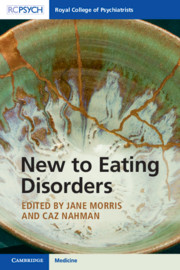Book contents
- New to Eating Disorders
- New to Eating Disorders
- Copyright page
- Contents
- Foreword
- Acknowledgements
- Introduction for Trainees and Students
- Chapter 1 What Are Eating Disorders?
- Chapter 2 Causes and Formulation
- Chapter 3 The Carer’s Perspective
- Chapter 4 Risk Assessment and Management
- Chapter 5 Ethical and Medico-legal Issues
- Chapter 6 Management of Eating Disorders
- Chapter 7 Nutritional Care: Dietetic Interventions Including Behavioural Interventions
- Chapter 8 Exercise and Activity
- Chapter 9 Body Image
- Chapter 10 Severe and Enduring Eating Disorders
- Chapter 11 Children and Adolescents
- Chapter 12 Transitions
- Index
- References
Chapter 6 - Management of Eating Disorders
Published online by Cambridge University Press: 12 June 2020
- New to Eating Disorders
- New to Eating Disorders
- Copyright page
- Contents
- Foreword
- Acknowledgements
- Introduction for Trainees and Students
- Chapter 1 What Are Eating Disorders?
- Chapter 2 Causes and Formulation
- Chapter 3 The Carer’s Perspective
- Chapter 4 Risk Assessment and Management
- Chapter 5 Ethical and Medico-legal Issues
- Chapter 6 Management of Eating Disorders
- Chapter 7 Nutritional Care: Dietetic Interventions Including Behavioural Interventions
- Chapter 8 Exercise and Activity
- Chapter 9 Body Image
- Chapter 10 Severe and Enduring Eating Disorders
- Chapter 11 Children and Adolescents
- Chapter 12 Transitions
- Index
- References
Summary
Dieticians play an important role in managing eating disorders – not just looking at nutrition but providing psychoeducation around nutrition, helping patients begin to normalise eating and making sure nutrition is adequate for growth, development and life-style. The reader is introduced to the depth and range of work that a dietician is able to provide.
- Type
- Chapter
- Information
- New to Eating Disorders , pp. 34 - 47Publisher: Cambridge University PressPrint publication year: 2020



